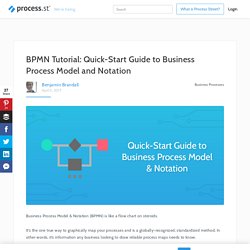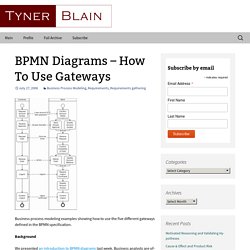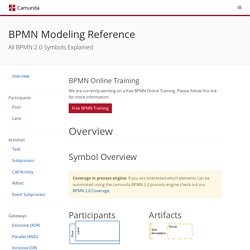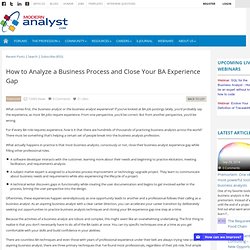

BPMN Gateway Types. BPMN Tutorial: Quick-Start Guide to Business Process Model and Notation. Business Process Model & Notation (BPMN) is like a flow chart on steroids.

It’s the one true way to graphically map your processes and is a globally-recognized, standardized method. In other words, it’s information any business looking to draw reliable process maps needs to know. When you map your processes (especially with a standardized method like BPMN), you start being able to: Get a clear vision of exactly how everything in your business worksSave time by eliminating unnecessary tasksReduce the rate your employees forget, overlook, or wrongly execute work So, what exactly is it? I compared it to a flow chart but much more than that: it has the functionality for representing things like information moving between teams, data being stored on the cloud, and departments working in parallel on the same process.
Although, at its simplest, a process map drawn with BPMN looks like this: It has been under active development since 2004, and is now widely accepted as the way to draw process maps. BPMN Examples, Patterns, and Best Practises. Free BPMN Tool Cawemo is a free online tool for designing, discussing and sharing BPMN diagrams with your team.

Free BPMN Tool We have taught BPMN to thousands of people and we apply the notation in our daily project work since 2007. Below you can find lots of BPMN examples of common modeling problems. Regardless of your specific project or your industry, there are a lot of common questions about using BPMN. We joined the OMG in 2009 as an influencing member. BPMN Tutorial: Quick-Start Guide to Business Process Model and Notation. How To Use Gateways. Business process modeling examples showing how to use the five different gateways defined in the BPMN specification.

Background We presented an introduction to BPMN diagrams last week. Business analysts are often required to document as-is processes and to-be processes. These diagrams help identify the scope of a software project. The diagrams can also help uncover requirements that might be overlooked without diagramming the processes. Client Request Error. BPMN Specification - Business Process Model and Notation. BPMN Modeling Reference - All BPMN 2.0 Symbols explained. BPMN Online Training We are currently working on a free BPMN Online Training.

Please follow this link for more information. Free BPMN Training Coverage in process engine: If you are interested which elements can be automated using the camunda BPMN 2.0 process engine check out our BPMN 2.0 Coverage. Events We already described how to use lanes to assign responsibility for tasks or subprocesses to different task managers. In the diagram below, the "conductor" arranges for Falko to process task 2 as soon as Robert completes task 1.
Do you think this is unrealistic? But to coordinate cooperation with BPMN requires explicit modeling. That seems complicated - and you don't have to choose this method for practical modeling. Have you heard of service orchestration in connection with Service Oriented Architecture (SOA)? You can eliminate pools and work just with lanes, modeling the message exchange as normal tasks as shown before. We will show the usefulness of this new thinking by example. Loop. BPMN and the Business Process Expert, Part 3: T... BPMN and the Business Process Expert, Part 2: M... BPMN and the Business Process Expert, Part 1. Why & How: Business Process Modelling > Business Analyst Community & Resources. Introduction The following diagram illustrates how process specifications are the pivot around which solutions are specified, designed and implemented: For larger image click here.

Processes are the user interface to a solution – as such they are highly visible and a lot of project effort is focussed on process modelling. In fact, there is a perception in some quarters that Business Analysts just draw process models and this is all they do. However, process models (the drawings of processes) are only one facet of the specification of a process. For larger image click here. This article will look at the reasons why process modelling should be done (the benefits) and the techniques for: 5 Key Benefits of Business Process Modeling > Business Analyst Community & Resources. Business Process Modeling is becoming a higher priority for business managers and analysts as there is an increasing emphasis in organizations to document, understand and improve their business processes.

Managers and business owners are realizing that operating their businesses without well documented processes is just like a pilot who is flying blind without properly functioning instruments and navigation. Well documented and streamlined processes are essential in a smooth functioning of a team as they help ensure consistency, trackability and focus towards a shared goal. Bridging the Gap between Business and Software Architectures > Business Analyst Community & Resources. We are frequently asked about connecting and tracing software architecture elements to business processes by integrating BPMN business models and software models in UML (Unified Modeling Language).

In our previous Modern Analyst article Powerful Business Modeling with No Magic’s Cameo Business Modeler @ Modern Analyst, we focused on capturing various aspects of business architecture: business processes, business data, and organizational structure. Now we will explore how to supplement business architecture with software architecture. Home Peritoneal Dialysis: a BPMN model and use of 5S principles > Business Analyst Community & Resources. The purpose of this article is to show an example of using Business Process Model and Notation (BPMN) to document the home medical process of peritoneal dialysis plus using 5S principles in the treatment workspace.

Caveat: The information provided in this article is not intended to be a substitute for professional medical advice. A licensed healthcare professional should be consulted for diagnosis and treatment of any and all medical conditions. Recently, my wife was diagnosed with poor performing kidneys and was introduced to peritoneal dialysis as opposed to hemodialysis. In being trained in this home procedure, I noted there were good text instructions, but no graphic model of the process. How to Analyze a Business Process and Close Your BA Experience Gap > Business Analyst Community & Resources.
What comes first, the business analyst or the business analyst experience?

If you’ve looked at BA job postings lately, you’d probably say the experience, as most BA jobs require experience. From one perspective, you’d be correct. But from another perspective, you’d be wrong. For if every BA role requires experience, how is it that there are hundreds of thousands of practicing business analysts across the world? There must be something that’s helping a certain set of people break into the business analysis profession. What actually happens in practice is that most business analysts, consciously or not, close their business analyst experience gap while filling other professional roles.
A software developer interacts with the customer, learning more about their needs and beginning to practice elicitation, meeting facilitation, and requirements analysis. Because the activities of a business analyst are robust and complex, this might seem like an overwhelming undertaking. That’s it. Efficient BPMN: from Anti-Patterns to Best Practices > Business Analyst Community & Resources. Introduction Business Process Model and Notation (BPMN) is already acknowledged as a de facto standard for business process modeling.

However, it still takes a long journey to increase the maturity of business process modeling practice. In practice most business analysts do a lot of mistakes that make their BPMN models over complex, difficult to understand and maintain. BPMN Quick Reference Guide - At a Glance > Business Analyst Community & Resources. BPMN Content on InfoQ. It’s Business Process Management » BPMN.
BPMN is the global standard for process modeling and one of the most important pieces in the puzzle of successful business-it-collaboration. As influencing members in OMG, we have been participating in the development of BPMN 2.0, the newest version of the standard, that allows both business modeling and technical execution of processes. defining guidelines for BPMN BPMN is very powerful, but applying it in practice can become a big struggle.
This does not mean that BPMN does not work, e.g. because it is too complicated for business (see also “BPMN – just DO it“). The important thing is that you recognize BPMN’s complexity which is a direct result of it’s expressiveness, and learn how to use BPMN for your special purposes. BPMN 2.0 is no silver bullet! We have been using BPMN for several years now, in a lot of projects. Camunda BPMN-Framework This is the reason why we created, besides other things, the “camunda BPMN-Framework”. Typical BPM-Roles . BPMN 2.0 - Introduction to the Standard for Business Process Modeling. BPMN Method and Style, Second Edition, with BPMN Implementer's Guide eBook: Bruce Silver: Kindle Store. Introduction To BPMN 2. BPMN Tutorial - BPMN 2.0 Tutorial for Beginners - Learn BPMN.
When naming tasks, we try to adhere to the object-orientated design principle of using the [verb] + [object] pattern. We would say "acquire groceries," for example, not "first take care of shopping for groceries. " Events refer to something that has already happened regardless of the process (if they are catching events) or as a result of the process (if they are throwing events). For this reason, we use the [object] and make the [verb] passive in voice, so we write "hunger noticed. " BPMN does not require you to model start and end events for a process - you can leave them out - but if you model a start event, you must model an end event for each path. The same is true for end events, which require start events.
BPMN Modeling Reference - All BPMN 2.0 Symbols explained. Coverage in process engine: If you are interested which elements can be automated using the camunda BPMN 2.0 process engine check out our BPMN 2.0 Coverage. Events We already described how to use lanes to assign responsibility for tasks or subprocesses to different task managers. Lanes always exist in a pool, and the lane boundaries represent process boundaries from start to end.
What's the best bpmn (2.0) book? Process Modeling With BPMN - Business Process Expert. Exclusive BPX Community Content: Dr. Bruce Silver is an independent industry analyst and consultant focused on business process management software. Dr. Silver provides training on process modeling with BPMN through www.bpmessentials.com, the BPM Institute, and Gartner conferences, and is the author of The BPMS Report series of product evaluations available from www.bpminstitute.org. Books & Articles. This book was published by Meghan Kiffer Press which offers the largest collection of BPM books. Business Process Management: The Third WaveFingar, Peter and Smith Howard. 2002 Don't bridge the business-IT divide: Obliterate it! The book is the first authoritative analysis of how third-wave business process management (BPM) changes everything in business and what it portends.
While the vision of process management is not new, existing theories and systems have not been able to cope with the reality of business processes --until now. This book describes a radical, simplifying shift in process thinking and technology that utterly transforms today's information systems and reduces the lag between management intent and execution.